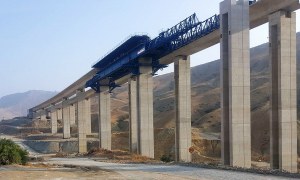🕑 Reading time: 1 minute
STEPS IN ANALYSING A BRIDGE
The analytical process for structure of bridges can be broken down to six main steps:
- Idealise the structure
- Form a model
- Idealise the loading in a form suitable for the model
- Solve the resulting equation
- Interpret the idealized results
- Check these results so that they comply with initial assumptions and meet any specific criteria.
The word idealized is used because the bridge engineer needs to be aware that he is only analyzing an idealized model of the bridge and not the bridge itself.
1. Idealise the structure:
This is generally a process of simplification whereby the real bridge members are replaced by simplified models. For example, beams may be replaced by line elements. These line elements have length and stiffness but no depth or breadth. They are thus idealization of real beams as shown below.


The bridge designer must remember that these lines do represent real beams with breadth, depth and reinforcement. For they will have to return from one idealized bridge design to the real one in order to select reinforcement and prestressing and check compliance.
2. Form a model:
Once the idealized structure of line elements has been produced it must then be allocated both stiffness and areas. The values to be calculated will depend on the type of model that is being formed. A 2D beam only requires bending stiffness and cross-sectional area to be calculated.
A 2D grillage model requires both bending and torsional stiffnesses but no area as there are no axial load present.

Fig: 2-D Grillage Model
Bending in beams leads to torsion in beams at 90degree.
A 3D space frame model will require bending and torsional stiffness and areas in several directions. Nearly all the models will require the elastic modulus to be supplied.
3. Idealise the loading:
In general, loading will have been specified as part of the design. The specification is likely to be in terms of a codified loading that has been already idealized. Typical examples for bridges in Britain are HA and HB loading as specified by the Highways Agency code BD 37/88. Another example of idealization is office loading. Think of the contents of a typical office: desks, chairs, filling cabinets, people etc. However this is very inconvenient to analyse as individual components, so it is idealized as a uniform loading as shown below.

Fig: HB loaded vehicle

Fig: Idealization of office loading
Likewise, bridge loading is idealized into uniform line and point loads to represent typical traffic behavior (of speed, weight, impact, bunching etc). fortunately most of the idealization has been done by the code authors. Much of the remaining idealization has been done of authors of the commercial computer programs.

Fig: Converting points loads to uniformly distributed loads.
For instance, grillages only take vertical loads at each node. It would be extremely tedious to convert standard HA and HB loads into node loads for each load case by hand. This tedium has been removed by commercial analysis programs which contain pre-processors which do this automatically.
4. Solve the resulting equation:
If the model selected is a simple one, then the equations of structural analysis can be solved by hand using such method as moment distribution or known coefficients such as WL/8. However, if a method such as grillage or finite element analysis has been used then a computer program will normally be used to solve the equations. Typically the stiffness matrix method is used.
The use of computers has meant that much larger and more complex designs can now be tackled without worrying about computation time and effort.
5. Interpretation of the idealized results:
The results obtained from the analysis will generally be moments, shears, axial forces, torsions, deflections and rotations. These results are only applicable to the idealized structure. The reverse of the idealization process needs to be applied.
For example, slab moments are shears need to be averaged out per meter width. Grillage moments will have a sawtooth appearance which does not occur in real structures.

The grillage moments need to be smoothed by averaging to give true value. As with the analysis the results need to be interpreted in relation to the true structure.
6. Checking the results:
The importance of this part of the procedure should not be underestimated. Only simple hand checks are generally required, but they can be used to great effect to confirm, the input data, the working of the model, the inclusion of all loading and the other of magnitude of the results.
A typical example is the grillage analysis of a simply supported bridge deck. For a typical load case, the total load applied to the grillage model is known. The support reactions should then be summed together for that load case. The two total values should be equal. If there is a significant difference between the load cases, this implies that the load cases have not been applied to the modal properly.
A typical longitudinal beam can be viewed in isolation with a proportion of the deck loading. The moments and shears obtained from the isolated beam should be similar to those from the corresponding member in the grillage model. Again, if there is a significant difference this implies that there is a problem with the model.
Only a few simple checks are required, and they can be selected at random from the known load cases. Once the designer has satisfied themselves that they are happy with the checks they can proceed with using the model results.
NOTE: HA & HB LOADINGHA loading consists of uniformly distributed loads combined with line loads. HB loading, on the other hand represents a standard abnormal vehicle which could weigh upto 180 tonnes on each axle.


